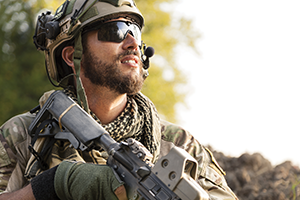The digital soldier

The Chief Technical Officer of Defence Forces Ireland, Commandant Damian Griffin, discusses the challenge of keeping the military’s ICT systems up-to-date and secure.
The office environment of the Irish Defence Forces is a little bit different to the average workplace. The Defence Forces support 9,500 personnel, 8,500 in the army and 1,000 in the Navy and Air Force. As Chief Technical Officer, Damian Griffin has responsibility over 20 sites, eight ships and troops deployed overseas who must get the same digital experience as those based on home soil.
The challenge of securing the Defence Forces’ digital network is made harder due to the fact there is such a wide range of equipment that needs to be secured across multiple networks. The need to ensure that a normal desktop PC, telephone, artillery fire control and battle management system can communicate securely with each other is of paramount importance as in this line of work, lives are constantly at risk.
IT as an enabler
The Defence Forces’ (DF) team operate in a very challenging environment and any solution this team provide must be intuitive to the soldier on the ground. A high level of ICT skills cannot, Griffin feels, be assumed at any point. In his view, the soldier simply needs IT to enable what they are doing on the ground, as he realises they are focused on achieving the mission on any given day.
The concept of keeping things simple for the end user is one that Griffin feels should be held by every professional working in the ICT sector. “When we keep things simple for the soldier it increases their confidence in us,” Griffin said. “If we give confidence to our soldier in the ICT we deliver, that will bring confidence in the senior leadership of our organisation and I see this as no different in government.
“If citizens have confidence in how their government does their business that will actually create confidence in the government, the politicians and the senior decision makers. Citizens just want to get to their information in a simple and straightforward way.”
Security
At present, Griffin and his team are focused on innovating and evolving securely. Talking about cyber security, Griffin’s mantra is focused once again, on keeping things simple despite the difficult challenges they are facing. “To keep things simple I ask, does the solution I’m looking at provide a solution for a point in time or will it fit into the entire ecosystem? We are moving towards a stage where everything will interoperate with everything else so the solution we put in place will be very important.”

The first thing Griffin’s team looked at was classified DF data and how this must be secured, converged and searchable. To tackle this challenge, the Defence Forces educated personnel to MSc level in information knowledge management to ensure the delivery of a suitable platform. This approach has received European and international recognition and Griffin is more than happy to share the lessons learnt with any government department or commercial entity.
The Defence Forces now have a single point of truth for information. There is only one version of a document and only one place where personnel can access information. Griffin feels that this solution provides the opportunity for excellent collaboration and sharing within their environment. “This was and continues to be a big cultural change for our organisation,” Griffin admits. “As a security first organisation we’re set up not to tell you something and silo our information, so to tell people they don’t have a network drive they have to put the information up somewhere where other people might be able to see it was initially a big change because as we all know, information can be power.”
Today, the network provides a physical separation of services at a hardware level and forbids remote access to the services. This environment is highly secure yet requires a high level of support and lacks flexibility. Griffin acknowledges that there are “business” challenges with this system and his team are currently “looking at how we can securely evolve this type of model in a way to keep both the technologists and the users happy.”
Ultimately, he hopes to be able to deliver a network based heavily on security with a high level of flexibility to deliver efficient and timely services. Yet in the delivery of this flexible system he is determined to ensure the confidentiality, integrity and the availability of Defence Forces’ data remains intact.
Future developments
Looking to the future, Griffin feels that “secure network evolution will deliver a focused ICT environment into the future for the Defence Forces.” The network will deliver an efficient and user centric environment that takes advantage of the changes in technology to support an intelligent workforce, network and organisation. Griffin realises the digital soldier is one that demands a simple, technically open, and intelligent network wherever that is, be it sitting in a barracks or on the front line in Syria.
The importance of technology in all our lives has increased massively in the last decade, however Griffin acknowledges that when it comes to technological implementation in the Defence Forces, the wide age range of the user base poses an additional challenge. “We all have to face the tsunami that is technology and remaining current,” Griffin claimed. ”We have to develop solutions for a digital immigrant like a Sergeant Major who is high structured in thought and is now looking at the digital native wanting to update a social media feed while operationally deployed.”
“Whilst this may not seem like the best idea, we have to remember this digital native is the future of our organisation so we have to, within our very tight confines, find some way to accommodate for this individual. If we don’t provide it that will be a problem for us as much as anyone else, the digital native will always find a way around your system if you don’t provide a solution for them.”





